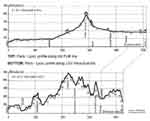
|
The new TGV logo, unveiled in September 2000. By clicking on the
thumbnail you will get a larger .jpg version, but you can also get the
original Photoshop format here (288 kB file,
to download Right-click, Save Target As...). The Photoshop version, which
comes directly from where it was designed, is in two layers: the logo
itself and its drop shadow.
|

|
The new TGV logo, unveiled in September 2000. As is evident on
this photo, the job of applying the new decals was done very quickly
without properly removing the old logo whose outline still shows on the
blue background.
Photo by Alexandre Kampouris (Xelax@Radio-BIP.qc.ca)
|

|
A photo of Mélusine, SNCF's high speed track and vehicle dynamics car. Mélusine can
be spliced into any TGV trainset; the electrical connectors on the ends of the car are
fully compatible. The car performs a two-week inspection cycle of the entire TGV network,
at full track speed. Unlike slower track inspection vehicles used on TGV track (such as
the Mauzin car), Mélusine uses accelerometers to measure the track geometry at high
speed. When not performing inspection duty, Mélusine can be used to test new TGV
trainsets. At the near end of the car on the photo is an elevated cab, used to view the
train's pantograph and the overhead catenary. Most of the center section is occupied by a
laboratory bench with racks for modular instrumentation units, which can easily be be
reconfigured for different missions. Paris Bercy, September 1996.
Photo by Clem Tillier (ctillier@alumni.princeton.edu)
|

|
Mélusine once again, spotted at Gare de Lyon in Paris. In this photo
you can see the observation cab on the left. The TGV power car is to the right.
Some of the aerodynamic roof fairing is removed, compared to the previous photo.
Photo by Claude Langlois (mountain@videotron.ca)
|

|
Mélusine once again, as it looks when inserted in a TGV trainset
Photo: Pierre Julien. Scan: Yann Nottara (ynottara@mail.dotcom.fr)
|
|
| 
|
The view from the Mélusine observation cab. We are looking
backwards at the pantograph on top of the trailing power car of a TGV
trainset. The high voltage roof cable supplying the front power car
(behind us at the other end of the train) is visible in the picture.
Photo and Scan by Anonymous
|

|
The Savas Mepin bridge on the LN4 high speed line, approx. PK 437 (PK = kilometer
point). Another illustration of how steep high speed lines can be.
Photo: Guy Laforgerie. Scan: Yann Nottara (ynottara@mail.dotcom.fr)
|

|
A photograph for cultural reference: the aftermath of the 1955 world speed record.
After a train passed at 331 km/h, the originally straight track was left in this state by
the wild hunting motion of the locomotive (BB 9004 and CC 7107, on separate occasions). In
contrast, The 1990 world speed record, set at 515.3 km/h by TGV 325, had no effect on
track alignment.
Photo by La Vie du Rail, Scan by Yann Nottara (ynottara@mail.dotcom.fr)
|

|
TGV Duplex 202 and (4-system) TGV Thalys 4341 nose to nose at the SNCF open house at
Bercy, September 1996.
Photo by Yann Nottara (ynottara@mail.dotcom.fr)
|
|
| 
|
A renovated TGV Sud-Est next to a TGV Duplex.
Photo by Yann Nottara (ynottara@mail.dotcom.fr)
|
|
| 
|
Three pages from a TGV timing plan, as used by the engineer to keep time on the run.
This is for TGV 607, service from Paris Gare de Lyon (departure 10:00 AM) to Lyon Perrache
(arrival 12:13 PM), valid for winter 96/97.
The left column is maximum authorized speed, in km/h. The next columns are respectively
kilometers from Paris, reference speed, landmarks, and expected time. A few clarifications
are in order: BV means station building ("bâtiment voyageurs"), BIF means
junction ("bifurcation"), PK means kilometer point ("point
kilometrique"), PRS means signal box, and a '+' after the time signifies an
additional 30 seconds.
SNCF document; Scan by Yann Nottara (ynottara@mail.dotcom.fr)
|
|
| 
|
An experimental front air dam is being developed for TGV trainsets.
This part sustains the most damage in a high speed collision with
animals which may find their way onto the track despite the fencing.
Since the air dam usually gets bent under the train it has proved
difficult to remove in the field, resulting in unnecessary delays. The
new air dam shown here consists of three pieces held together with
quick-release fasteners. It can be removed easily in the field and is
currently being tested on several trainsets, until a few collisions show
whether a retrofit to the entire TGV fleet would be cost-effective.
Photo: unknown, Scan by Yann Nottara (ynottara@mail.dotcom.fr) |
|
| 
|
Profile comparison of the old Paris - Lyon PLM line and the new LGV PSE
high speed line. This shows the dramatic profiles made possible by high speed
rail, thanks to the proportionally smaller speed loss on hills. The new line
is built on a much shorter and direct route and has no tunnels. Both of these
benefits come from the enormously steep grades (by mainline railway standards).
On such grades the head and tail of a multiple-unit pair of TGV trainsets can
be separated by the height of a five story building!
Source: Chemins de Fer Magazine (AFAC)
|
|
|
|
|
|
|
|
|